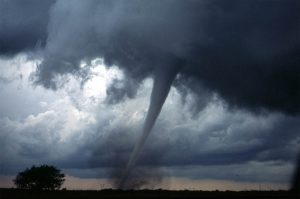 Courtesy of iii.org
Courtesy of iii.org
A tornado is a violently rotating column of air that extends from a thunderstorm and comes into contact with the ground, according to the National Oceanic and Atmospheric Administration (NOAA). In an average year about 1,000 tornadoes are reported nationwide, according to NOAA. Tornado intensity is measured by the enhanced Fujita (EF) scale. The scale rates tornadoes on a scale of 0 through 5, based on the amount and type of wind damage. It incorporates 28 different damage indicators, based on damage to a wide variety of structures ranging from trees to shopping malls.
The U.S. experiences more tornadoes than any other country in the world, according to a 2013 report by Lloyds of London. (See Executive Summary, page 4 of Tornadoes a Rising Risk? for additional findings and statistics.)
The Fujita Scale For Tornadoes
|
(1) Original scale: wind speeds represent fastest estimated speeds over one quarter of a mile.
(2) Enhanced scale: wind speeds represent maximum 3-second gusts.
Source: U.S. Department of Commerce, National Oceanic and Atmospheric Administration.
INSURED LOSSES
The United States experiences more tornadoes than any other country. Tornadoes accounted for 40.2 percent of insured catastrophe losses from 1996 to 2015, according to Verisks Property Claim Services (PCS). In 2015 insured losses from U.S. tornadoes/thunderstorms totaled $9.6 billion, down from $12.3 billion in 2014. The National Oceanic and Atmospheric Administration notes that tornadoes can happen any time of year. The costliest U.S. catastrophe involving tornadoes, based on insured losses, occurred in April 2011. It hit Tuscaloosa, Alabama, and other areas, and cost $7.8 billion in insured damages (in 2015 dollars). That event was the 10th costliest U.S. catastrophe, based on insured losses, according to PCS. The second costliest catastrophe involving tornadoes, based on insured losses, struck Joplin, Missouri, and other locations in May 2011. The catastrophe cost $7.3 billion in insured losses in 2015 dollars. (See chart below.) The National Weather Service posts updated information on tornadoes.
THE 2014-2016 TORNADO SEASONS
Preliminary NOAA data show that there were 1,059 tornadoes in 2016, compared with 1,177 in 2015. On January 17, tornadoes developed in Florida with two fatalities. On February 23 and 24 tornadoes formed in Louisiana, Mississippi and Virginia resulting in two fatalities in Louisiana, one in Mississippi and four in Virginia. February 23 was the most active tornado day in 2016, when 52 storms formed. On April 27, one fatality resulted from a tornado in Texas and on May 9 tornadoes in Oklahoma killed two people.
The number of tornadoes rose to 1,177 in 2015 from 886 in 2014, according to the National Oceanic and Atmospheric Administration (NOAA). There were 36 direct fatalities from tornadoes in 2015, down from 47 in 2014, according to NOAA. May was the top month for tornadoes in 2015, with 381 tornadoes. There were 17 tornado-related fatalities in Texas in 2015, followed by 11 in Mississippi and two each in Arkansas, Illinois, Oklahoma and Tennessee.
NOAA data show that there were 886 tornadoes in 2014, compared with 906 in 2013. On April 27, 30 tornadoes formed in seven states (Arkansas, Iowa, Nebraska, Kansas, Oklahoma, Mississippi and Louisiana). Nineteen fatalities were reported. Many homes and buildings were damaged or destroyed in Arkansas, Oklahoma and Kansas, according to the Federal Emergency Management Agency. On April 28, tornadoes in five states (Alabama, Georgia, Kentucky, Mississippi and Tennessee) resulted in 15 fatalities. There were 47 direct fatalities from tornadoes in 2014, down from 55 in 2013, according to NOAA. June was the top month for tornadoes in 2014, with 287 tornadoes.



